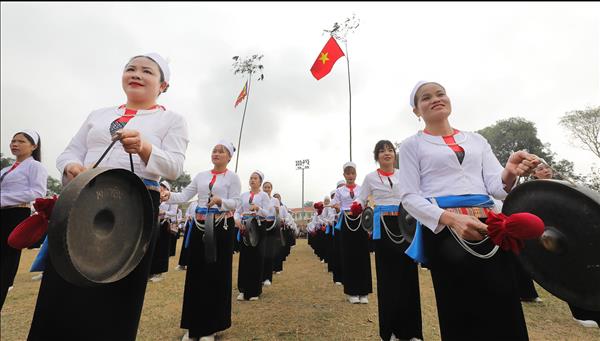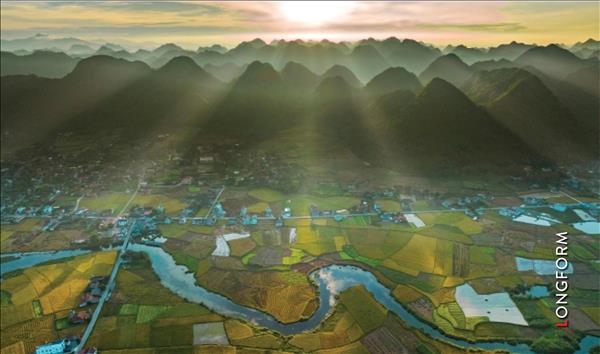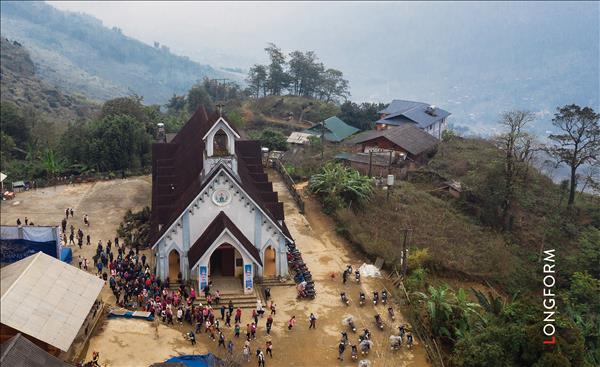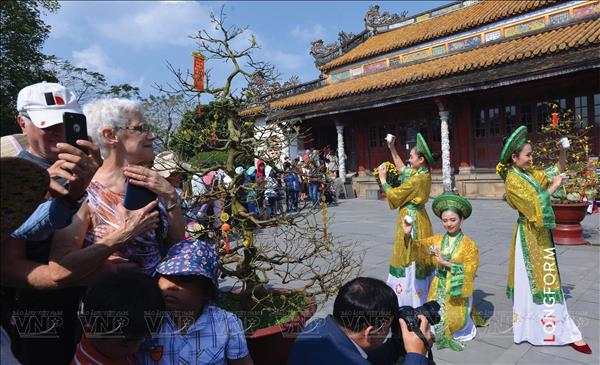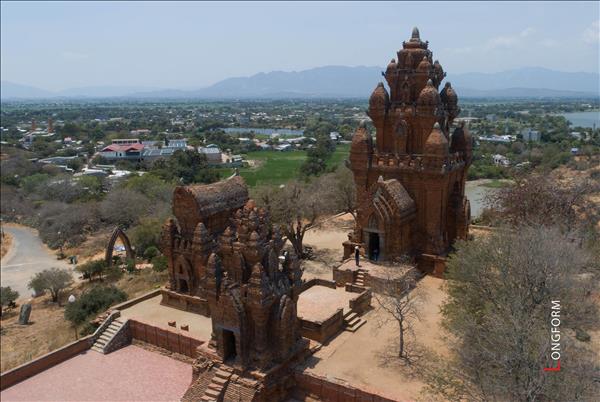A Breakthrough with Technology
The establishment of the traditional flower village of Ha Dong in 1938, then the flower villages of Thai Phien and Van Thanh, with a total cultivation area of some 240ha, marked the emergence of traditional flower-growing craft villages in Da Lat. From then on, this misty land known as an entertainment and recreation resort of local aristocrats and French officials in Indochina during the colonial time became famous for its flower growing.
By the 1990s, the traditional flower-growing craft in Da Lat strongly developed thanks to the application of technical and scientific measures to production by flower farm owners. The emergence of Agrivina Limited Liability Company (Dalat Hasfarm) in 1994 created a great turning point in flower growing in Da Lat with the hi-tech agricultural production model.
Dalat Hasfarm started its business with a 2ha-farm growing roses and dianthus using modern technology with a system of glasshouses, net houses and automatic spray watering, imported from Israel and the Netherlands. Also with modern technology, the enterprises successfully grew chrysanthemums of different kinds, which bloom during festivals or Tet (lunar New Year), hence higher prices at the markets. In addition to the application of modern technology, Dalat Hasfarm has expanded its cooperation with satellite farms in the region in order to create a stable outlet for farmers, on the one hand, and to expand and build up brands for Da Lat flowers, on the other hand. This has encouraged traditional flower growers in Da Lat to gradually shift to modern flower-growing methods.
Vo Van Co, a flower grower in Thai Phien flower village with more than 30 years’ experience, said: “My family moved from Hue to Da Lat in 1981, growing flowers using traditional methods. By 2000, my family and a number of others applied high technology to flower growing, thus resulting in double or triple outputs, shorter cultivation time and much less strenuous labour”.
The hi-tech agricultural production method has yielded high economic efficiency but with an initial investment capital larger than the traditional method. Therefore, the Agriculture and Rural Development Department of Lam Dong Province and Da Lat municipal administration have applied various practical measures to support local flower growers, especially the 2011-2015 program on hi-tech agricultural development with various policies in support of trial production and scientific-technological transfers such as tax exemption or reduction and low-interest loans, which have encouraged farmers to follow the new way of agricultural production. Da Lat has also re-planned the agricultural land towards developing hi-tech vegetable and flower-growing zones to suburban areas to facilitate sustainable production.
As early as 1978, the Potato-Vegetable-Flower Research Centre was set up in Da Lat, which has researched and applied such hi-tech agricultural solutions as tissue culture, new-strains creation, experimental growing of local plant varieties, and established production cooperation at home and abroad. Besides this centre, there also exists in Da Lat “Cong ty Rung Hoa Da Lat” (Da Lat Flower Forest Company), one of the local sapling farms, which has greatly contributed to the technological transfer, supply of new, clean and high-yield strains to farmers and enterprises in the region and provinces as well as cities with climate conditions similar to Da Lat-Lam Dong’s.
In recent years, there have appeared in Da Lat more private or foreign-invested enterprises such as Kim Bang, Bio-Organics and An Phu Lacue, which, with their advantages in high technology and large capital sources, have contributed to the formation of sizeable and modern vegetable- or flower-growing farms in Da Lat.
Da Lat Vegetables and Flowers in the World Market
If Lam Dong is among the hi-tech agricultural production leaders nationwide, Da Lat has become its standard bearer with the greatest contribution to this specialised farming region. The application of high technology to agricultural production has resulted in extremely great efficiency. The hi-tech agricultural production value doubles the province’s traditional production value, with high-quality vegetables reaching 450-500 million dong/ ha and high-quality flowers reaching 800,000-1.2 million dong/ha, thus making Da Lat in particular and Lam Dong province in general the greatest vegetable and flower supplier in the country.
In recent years, Da Lat flower brands have been diverse in types with thousands of native and imported varieties. Da Lat flowers have incrementally established their position on international markets where they can compete on an equal footing with strong flower growers around the world.
In the recent 2016 Binh Than Lunar New Year festival, Da Lat supplied about 150tonnes of vegetables per day for the northern market which suffered from a severe shortage due to harsh weather conditions, contributing to stabilising the consumption demands of people in peak months. Da Lat-Lam Dong vegetable products are diverse with such well-known kinds of fresh vegetables as lettuce, watercress, cabbage, cauliflower, potatoes, carrots, bush red peppers and bulb onions.
...
Da Lat vegetables have been produced using a mode of safety and is recognised by GAP standards. Many production units have acquired modern post-harvest preservation and preliminary processing technology and processes, thus making the products fresh and tasty as required by consumers.
Such specialised vegetable production units such as Kim Bang Company, Anh Dao Cooperative and Tan Tien cooperative have supplied vegetables directly to big stores nationwide while also expanding their retail networks to various localities to supply their products directly to consumers.
In addition, many vegetable and flower farms in Da Lat have taken advantage of the local tourist development to additionally develop a form of agro-tourism with beautiful vegetable and flower farms for visitors, thereby earning profits while branding their vegetable and flower growing.
At present, there exists in Lam Dong province about 11 projects invested in by Japanese enterprises in vegetable and flower production. A number of enterprises such as Lacue International, Capital company (Japan) and Jica organisation (Japan) have made certain contributions to local agricultural development through technical assistance and production cooperation.
With a long-term vision, Da Lat is pinpointed as a key clean and hi-tech agricultural production region of the whole country, being Vietnam’s “kingdom” of vegetables and flowers with many products of international grades.
Box: According to Lam Dong province’s Agriculture and Rural Development Department, by 2015, the hi-tech agricultural production had been applied on 43, 084ha as opposed to only 9, 800ha in 2010. Flower cuttings output increased from 150 million cuttings in 2001 to over 900 million in 2009, 1.5 billion in 2011 and 2.1 billion in 2013. The average production value/ hectare increased from 76 million dong in 2010 to 130 million dong in 2014 and 135 million dong in 2015. In 2015, Da Lat exported 250 million cuttings, earning more than 26 million dollars.
In addition to the application of modern technology, Dalat Hasfarm has expanded its cooperation with satellite farms in the region in order to create a stable outlet for farmers, on the one hand, and to expand and build up brands for Da Lat flowers, on the other.
The establishment of the traditional flower village of Ha Dong in 1938, then the flower villages of Thai Phien and Van Thanh, with a total cultivation area of some 240ha, marked the emergence of traditional flower-growing craft villages in Da Lat. From then on, this misty land known as an entertainment and recreation resort of local aristocrats and French officials in Indochina during the colonial time became famous for its flower growing.
By the 1990s, the traditional flower-growing craft in Da Lat strongly developed thanks to the application of technical and scientific measures to production by flower farm owners. The emergence of Agrivina Limited Liability Company (Dalat Hasfarm) in 1994 created a great turning point in flower growing in Da Lat with the hi-tech agricultural production model.
|
Many kinds of imported lettuce are grown using the aquatic farming method in Da Lat. Growing lettuce using the aquatic farming method at Kim Bang Farm in Ward 7, Da Lat. The application of high tech methods help increase the productivity of flowers two or three times more than the traditional method and shorten the farming time. Thanks to a suitable farming method and high tech application, plants in green houses in Lam Dong still grow at night. An automatic watering system is installed at every farms in Da Lat. The whole province of Lam Dong has 50 businesses using invitro technology that can produce 30 million saplings of various kinds of plants for locals and neighbouring areas. Separating tissues after the culture in the lab which is then tented in a special nutrias environment. Experts from Japan conduct a survey on the application of high-tech equipment to growing vegetables and flowers in Da Lat. |
| According to Lam Dong province’s Agriculture and Rural Development Department, by 2015, the hi-tech agricultural production had been applied on 43, 084ha as opposed to only 9, 800ha in 2010. Flower cuttings output increased from 150 million cuttings in 2001 to over 900 million in 2009, 1.5 billion in 2011 and 2.1 billion in 2013. The average production value/ hectare increased from 76 million dong in 2010 to 130 million dong in 2014 and 135 million dong in 2015. In 2015, Da Lat exported 250 million cuttings, earning more than 26 million dollars. |
Vo Van Co, a flower grower in Thai Phien flower village with more than 30 years’ experience, said: “My family moved from Hue to Da Lat in 1981, growing flowers using traditional methods. By 2000, my family and a number of others applied high technology to flower growing, thus resulting in double or triple outputs, shorter cultivation time and much less strenuous labour”.
The hi-tech agricultural production method has yielded high economic efficiency but with an initial investment capital larger than the traditional method. Therefore, the Agriculture and Rural Development Department of Lam Dong Province and Da Lat municipal administration have applied various practical measures to support local flower growers, especially the 2011-2015 program on hi-tech agricultural development with various policies in support of trial production and scientific-technological transfers such as tax exemption or reduction and low-interest loans, which have encouraged farmers to follow the new way of agricultural production. Da Lat has also re-planned the agricultural land towards developing hi-tech vegetable and flower-growing zones to suburban areas to facilitate sustainable production.
As early as 1978, the Potato-Vegetable-Flower Research Centre was set up in Da Lat, which has researched and applied such hi-tech agricultural solutions as tissue culture, new-strains creation, experimental growing of local plant varieties, and established production cooperation at home and abroad. Besides this centre, there also exists in Da Lat “Cong ty Rung Hoa Da Lat” (Da Lat Flower Forest Company), one of the local sapling farms, which has greatly contributed to the technological transfer, supply of new, clean and high-yield strains to farmers and enterprises in the region and provinces as well as cities with climate conditions similar to Da Lat-Lam Dong’s.
In recent years, there have appeared in Da Lat more private or foreign-invested enterprises such as Kim Bang, Bio-Organics and An Phu Lacue, which, with their advantages in high technology and large capital sources, have contributed to the formation of sizeable and modern vegetable- or flower-growing farms in Da Lat.
Da Lat Vegetables and Flowers in the World Market
If Lam Dong is among the hi-tech agricultural production leaders nationwide, Da Lat has become its standard bearer with the greatest contribution to this specialised farming region. The application of high technology to agricultural production has resulted in extremely great efficiency. The hi-tech agricultural production value doubles the province’s traditional production value, with high-quality vegetables reaching 450-500 million dong/ ha and high-quality flowers reaching 800,000-1.2 million dong/ha, thus making Da Lat in particular and Lam Dong province in general the greatest vegetable and flower supplier in the country.
In recent years, Da Lat flower brands have been diverse in types with thousands of native and imported varieties. Da Lat flowers have incrementally established their position on international markets where they can compete on an equal footing with strong flower growers around the world.
In the recent 2016 Binh Than Lunar New Year festival, Da Lat supplied about 150tonnes of vegetables per day for the northern market which suffered from a severe shortage due to harsh weather conditions, contributing to stabilising the consumption demands of people in peak months. Da Lat-Lam Dong vegetable products are diverse with such well-known kinds of fresh vegetables as lettuce, watercress, cabbage, cauliflower, potatoes, carrots, bush red peppers and bulb onions.
...
|
Harvesting flowers which are grown using a high-tech method at Dalat Hasfarm. Cutting Lys branches at Dalat Hasfarm. Packing roses at Da Lat Hasfarm. Packaging fresh flowers at Da Lat Hasfarm. Packing safe vegetables after sterilising and fanning to drain water. Packing and keeping vegetables in storage facilities at Dalat Hasfarm. The diversify and abundance of flowers of Dalat Hasfarm meet the different demands of customers. E-commerce is very useful for vegetable and flower growing businesses to promote and sell their products. |
|
In 2015, with more than 100ha growing chrysanthemums, roses, dianthus and forget-me-nots, Dalat Hasfarm supplied the market with 140 million cuttings and two million flower pots, accounting for 50% of the domestic market and 50% for export, becoming the local leading unit in export of fresh flowers to 12 regular markets in the world, including Japan, Taiwan, Australia, Malaysia and Singapore. (Ho Duc Trung, Business Director of Dalat Hasfarm) |
Such specialised vegetable production units such as Kim Bang Company, Anh Dao Cooperative and Tan Tien cooperative have supplied vegetables directly to big stores nationwide while also expanding their retail networks to various localities to supply their products directly to consumers.
In addition, many vegetable and flower farms in Da Lat have taken advantage of the local tourist development to additionally develop a form of agro-tourism with beautiful vegetable and flower farms for visitors, thereby earning profits while branding their vegetable and flower growing.
At present, there exists in Lam Dong province about 11 projects invested in by Japanese enterprises in vegetable and flower production. A number of enterprises such as Lacue International, Capital company (Japan) and Jica organisation (Japan) have made certain contributions to local agricultural development through technical assistance and production cooperation.
With a long-term vision, Da Lat is pinpointed as a key clean and hi-tech agricultural production region of the whole country, being Vietnam’s “kingdom” of vegetables and flowers with many products of international grades.
Box: According to Lam Dong province’s Agriculture and Rural Development Department, by 2015, the hi-tech agricultural production had been applied on 43, 084ha as opposed to only 9, 800ha in 2010. Flower cuttings output increased from 150 million cuttings in 2001 to over 900 million in 2009, 1.5 billion in 2011 and 2.1 billion in 2013. The average production value/ hectare increased from 76 million dong in 2010 to 130 million dong in 2014 and 135 million dong in 2015. In 2015, Da Lat exported 250 million cuttings, earning more than 26 million dollars.
In addition to the application of modern technology, Dalat Hasfarm has expanded its cooperation with satellite farms in the region in order to create a stable outlet for farmers, on the one hand, and to expand and build up brands for Da Lat flowers, on the other.
|
At present, Da Lat vegetables and flowers are consumed in most provinces and cities nationwide and are exported to Japan, Taiwan, Thailand, Singapore and Malaysia. |
Story: Son Nghia - Photos: Nguyen Luan

